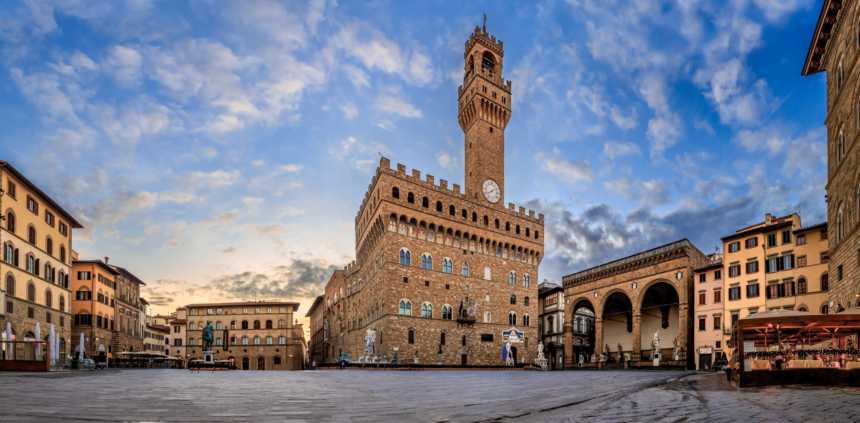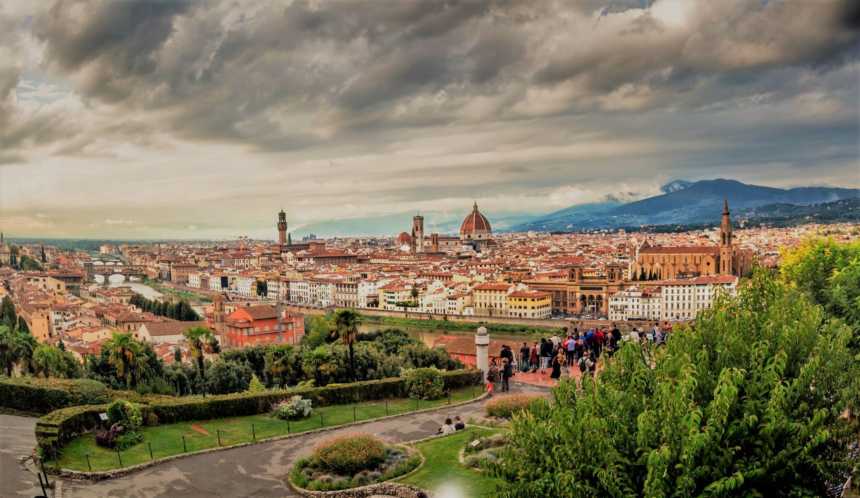Florence is one of our favorite cities in the entire world, and no matter how many times we go back, we will always plan to return. As the capital of the Tuscany region of Italy, Florence is renowned as one of the most cultural and historical cities in the world and is packed full of amazing architecture and places of significance.
During ancient history, Florence was once a Roman city and then developed into a thriving medieval commune. It is hailed as the birthplace of the Renaissance movement, and throughout the 12th, 15th and 16th centuries, was one of the most important cities of the world.
Today, tourism is undoubtedly a major part of the economy of Florence and an average of 13 million people visit the city each year. Cradled between the surrounding hills, the city hosts some of the most famous works of art on the planet and the whole of the city centre is packed with stunning palaces, churches and monuments.
Lets explore the best things to do in Florence:
1. Cattedrale di Santa Maria del Fiore

The Cattedrale di Santa Maria del Fiore (known simply as the Duomo) is not only Florence’s religious center, it’s also the city’s most recognizable attraction. Occupying the Piazza del Duomo in the heart of the city, this massive Gothic cathedral was erected during the 14th century on the former site of the Roman church, Santa Reparata.
The red-tiled cupola was designed by Brunelleschi and is described as a must-see by experts and travelers alike. Visitors like to joke that the cathedral was designed inside-out: its exterior boasts intricate designs and breathtaking features while the interior is surprisingly plain. For many, the main reason to visit is to climb to the top of the dome (the cupola) where you’ll find spectacular views of the city.
2. Uffizi Galleries

The Galleria degli Uffizi is one of the oldest and most famous art museums of the western world. The Renaissance masterpieces that you will find are quite unique and one of a kind (we are talking about paintings by famous artists such as Michelangelo and Leonardo da Vinci, for example).
This is one thing in Florence that we absolutely recommend purchasing tickets in advance for: lines are extremely long and can eat into your precious time in the gallery or the rest of Florence.
3. Piazza della Signoria

Piazza della Signoria, the historic and political center of the city, is just off of the River Arno and next to the Uffizi Gallery. Probably, the most famous piazza in all of Florence, Piazza Della Signoria is also something of an outdoor art museum. Here, you will find statues including the Fountain of Neptune, a replica of the Statue of David and Piazza della Signoria.
Florence’s historic seat of power and medieval fortress, Piazza della Signoria, dates back to the 13th century on top of Roman ruins by Arnolfo di Cambio. Its original purpose was to be the home of the city council made up of the powerful Guilds of Florence who governed the Republic of Florence. Today it is home to the mayor’s office and the municipal council.
4. The Baptistery

Its origins are unknown although it is believed that it was built over the ruins of a Roman temple dedicated to Mars dating back to the 4th-5th century A.D. It was first described in 897 as a minor basilica. In 1128, it was consacrated as the Baptistery of Florence and as such is the oldest religious monument in Florence.
The Baptistery, dedicated to Florence’s patron saint, has an octagonal plan and an octagonal lantern with a cupola. Outside it is clad in geometrically patterned colored marble, white Carrara marble and green Prato marble that is typical of Florentine Romanesque architecture.
On three of the four sides there are three large doors famous for their decorations. The most important door has always been considered the eastern doors, the ones that lead to the Duomo.
5. Accademia Gallery

Florence’s Galleria dell’ Academia, holds Michelangelo’s David, easily the most famous sculpture in the world. Located in close proximity to the Piazza del Duomo and the Basilica di San Lorenzo, the Gallery of the Academy also houses other sculptures and works from Michelangelo and is split into several different interesting halls.
Here you can find a wealth of historical art, and also a great deal of history pertaining to 14th and 15th century Florence.
6. Ponte Vecchio

The Ponte Vecchio, which translates as “old bridge,” was the only bridge across the Arno in Florence until 1218. The bridge first appears in a document of 996 and was destroyed by a flood in 1117.
In 1345, the bridge was reconstructed and made into a public thoroughfare, with rows of shops added to the bridge. Ponte Vecchio became a top place for gold and silver shopping in Renaissance Florence. The Ponte Vecchio is still lined with shops selling gold and silver jewelry today, and even if you’re not looking to buy, it’s a good place for window shopping.
It’s the only surviving bridge from Florence’s medieval days (others were destroyed in World War II).
7. Boboli Gardens

More than a garden, more than just a “green lung” in Florence, the Boboli Gardens are one of the greatest open-air museums in Florence that embraces another site of culture in Florence, the Pitti Palace.
Covering an area of 45,000 square metres, the gardens are some of the largest in Florence and are a true delight to walk through.
Created in the 16th century, the Boboli Gardens feature a myriad of different sections including a main lawn with a fountain and obelisk, a selection of worldly trees, plants and flowers, and several large ponds complete with water features.
If you want to escape the city, you can find solace in this wonderful place and enjoy the beautiful designs and natural specimens.
8. Piazzale Michelangelo

Located on the left bank of the Arno, Piazzale Michelangelo was built on the hills above the city in 1869, at a time when Florence was the capital of Italy.
Designed by architect Giuseppe Poggi, the panoramic terrace is dedicated to the great Renaissance artist Michelangelo, and offers uninterrupted views of Florence in all its splendour. The scene is particularly picturesque at sunset, when the entire cityscape unfolds and historic landmarks glisten in the red sun.
9. Piazza Santa Croce

Located in the Santa Croce neighbourhood, Piazza Santa Croce is a hive of local activity and you can also take in the views of the gorgeous basilica at the same time.
Once you’re here, make sure to keep your eyes peeled for the statue of Dante Alighieri and stop off for coffee in one of the local traders’ stalls. Oh, also head inside Palazzo Cocchi-Serristori and the totally stunning Palazzo dell’Antella (which are great).
Throughout the year, there’s also a range of leather merchants that sell local goods and crafts, too. Just remember to haggle if you’re buying a bigger purchase.
10. Pitti Palace

Located on the Southern Banks of the River Arno, the Palazzo Pitti has stood since the 1400’s as a fine example of Renaissance architecture. A grand square sits at the front of the palace and frames the symmetrical front facade perfectly.
Although once home to Italian royalty and powerful families such as the Medici’s, the palace now stands as the largest museum complex in Florence. Inside the palace, there are a myriad of different galleries that are all richly decorated, but also contain a host of Renaissance artwork.
The Jupiter room for example contains some amazing frescos but also the famous Veiled Lady by Raphael. Other well known artists featured include Titian, Rubens, Caravaggio and Vernonese.


